



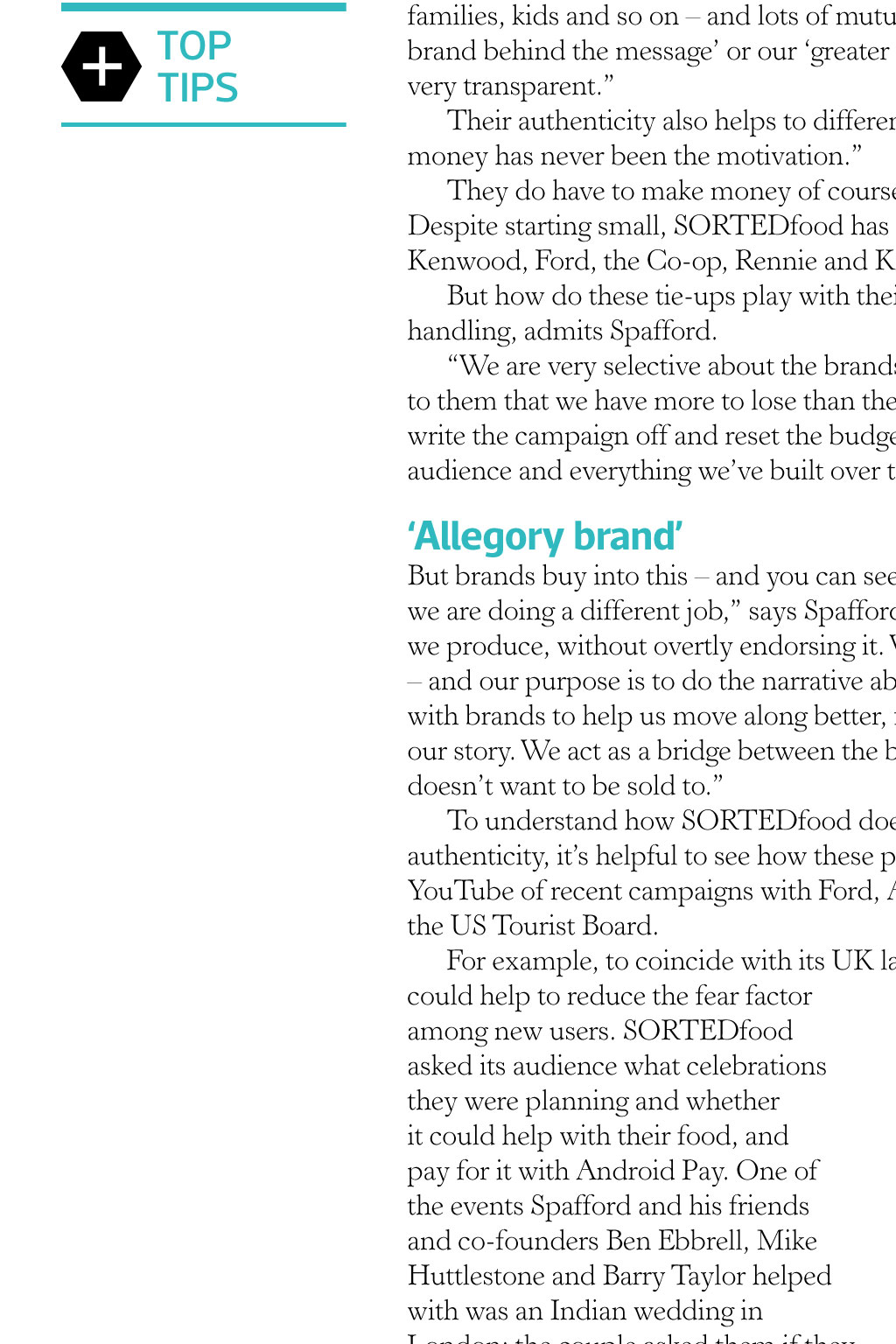
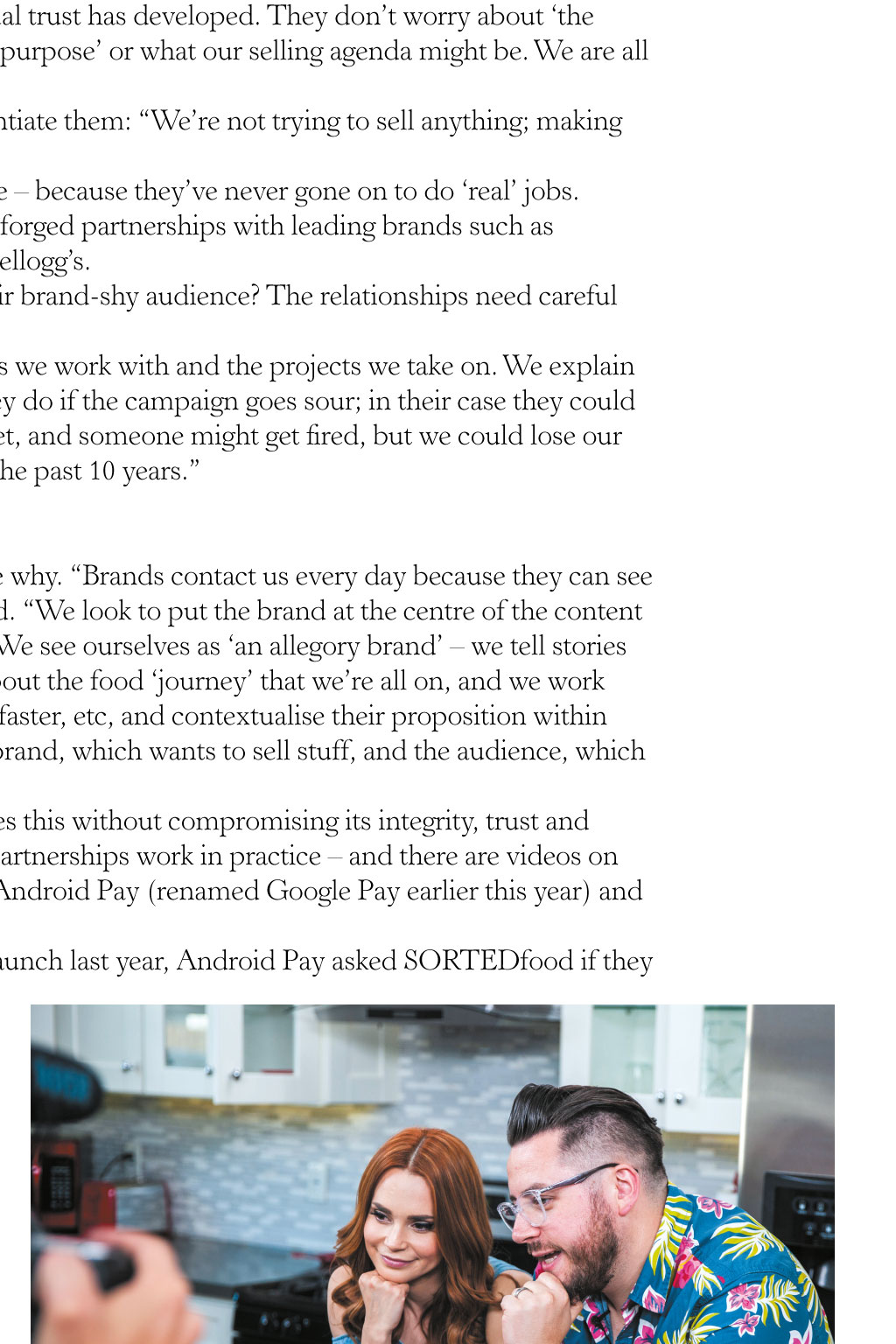
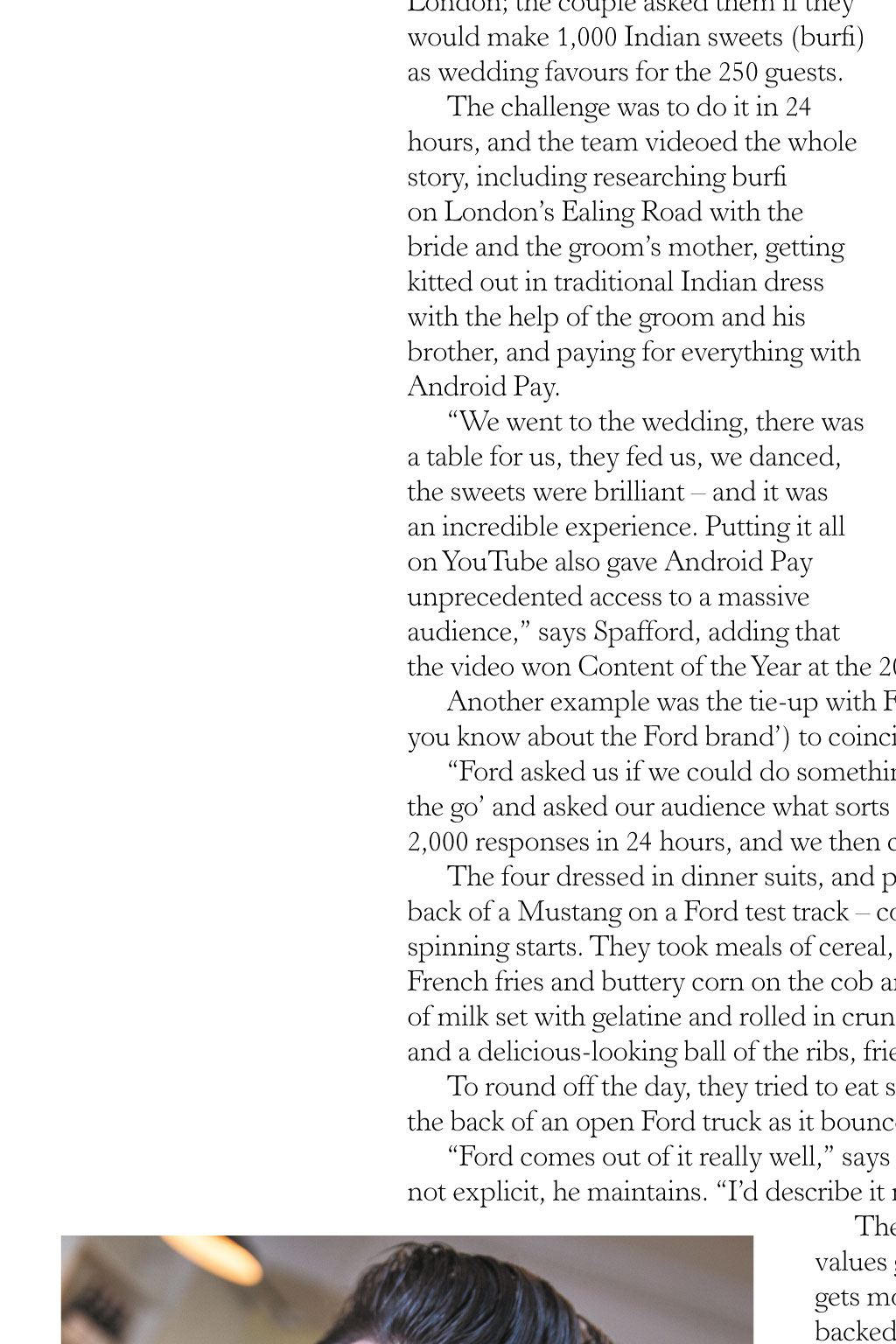
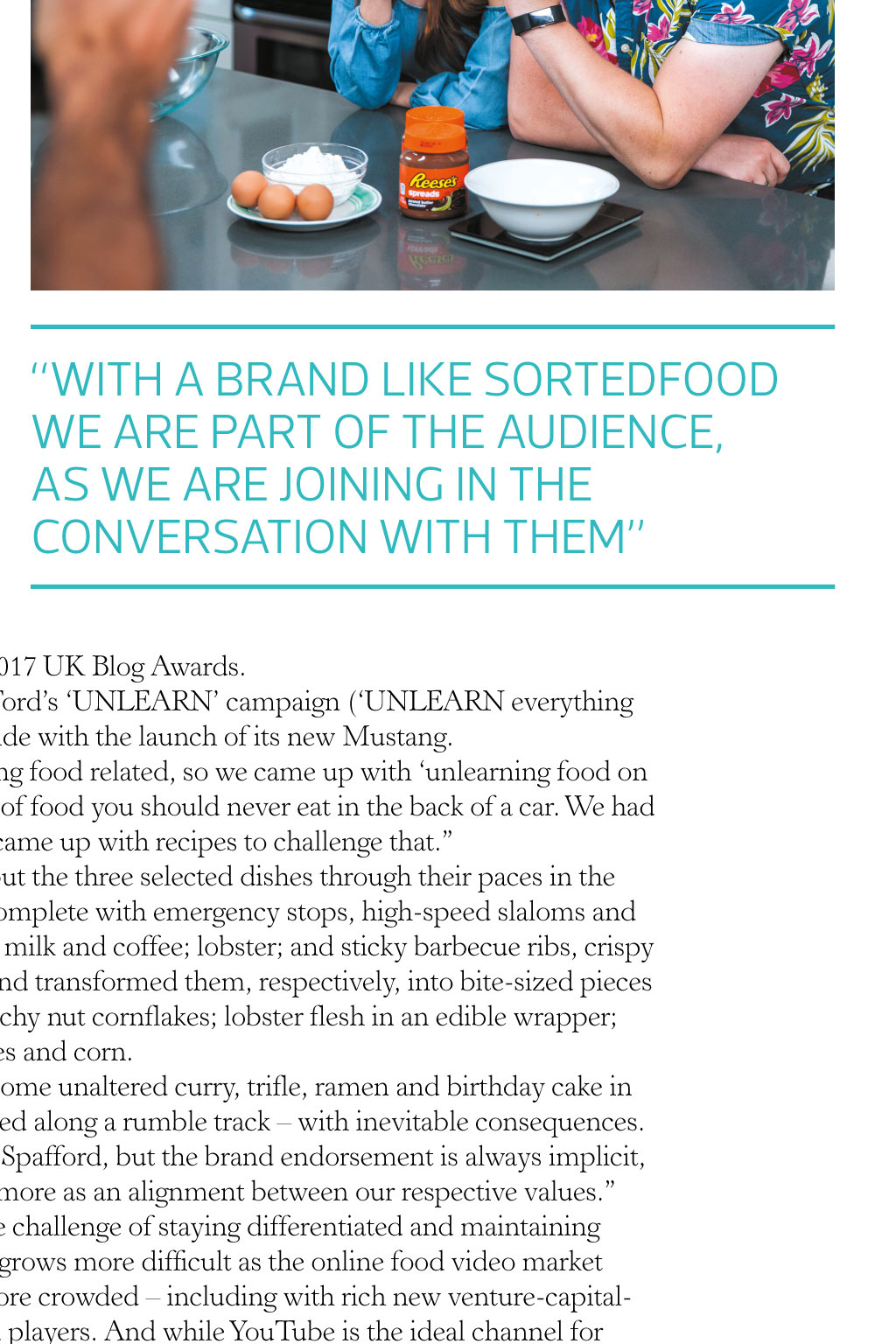
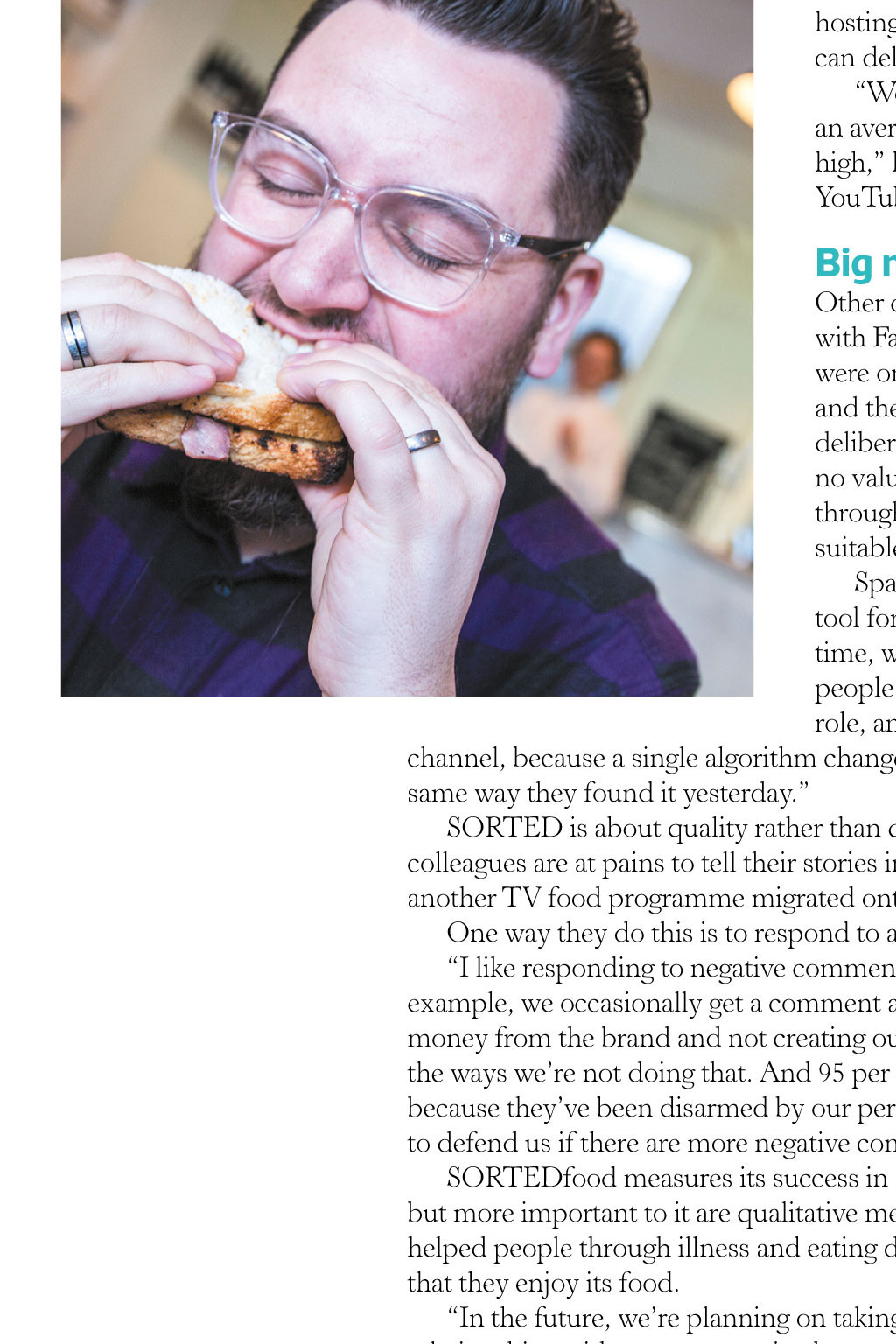
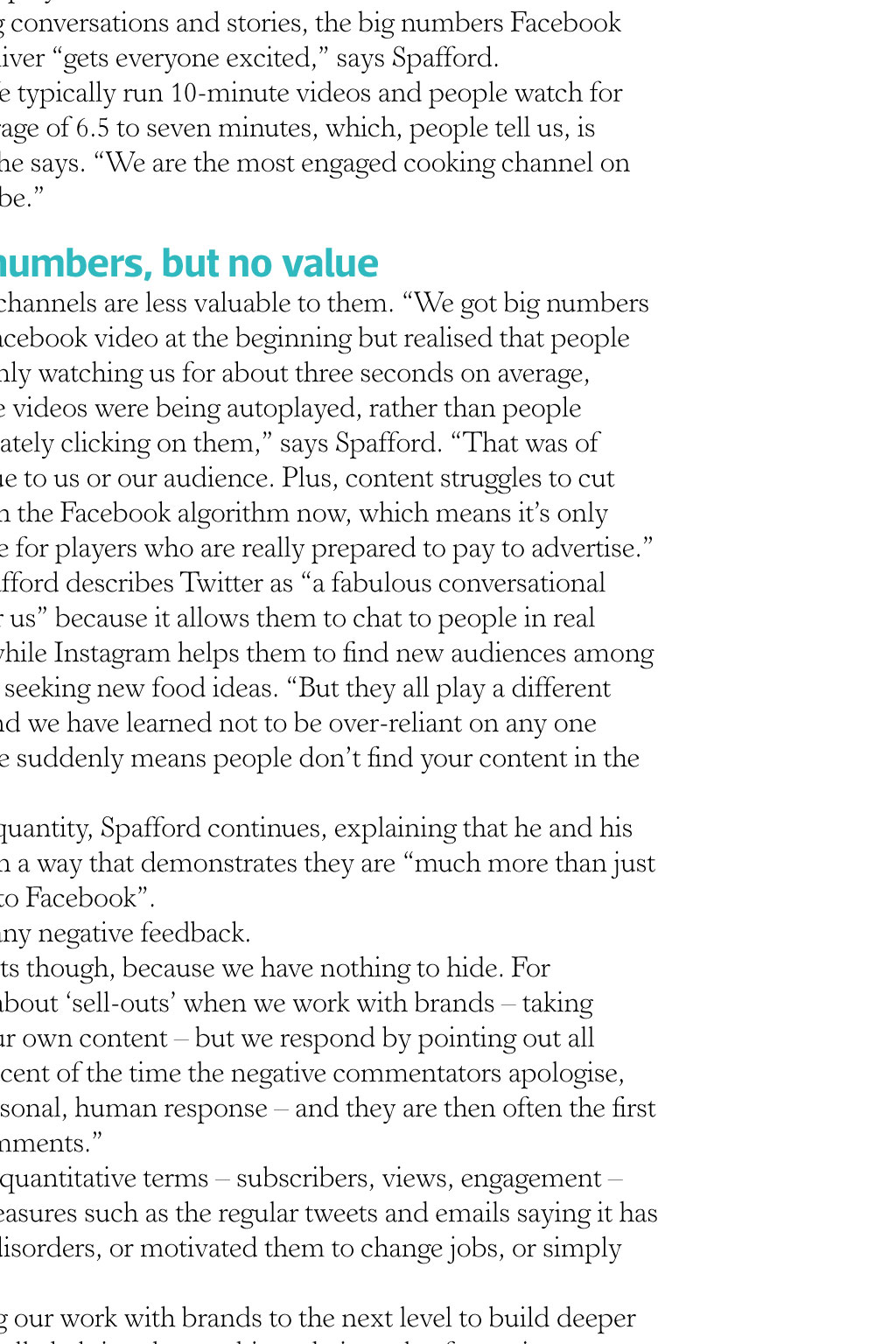















Trailblazer Social tastes Watch SORTEDfood At SORTEDfood, the YouTube food and lifestyle channel that boasts 25,000 hours per day of content watched, co-founder Jamie Spafford says forging connections with millennials requires a paradigm shift in communications interview: jane simms Keeping it real... three of the four founders of SORTEDfood S ORTEDfood is almost an accidental brand yet it captures the zeitgeist perfectly. Conceived 10 years ago by four old schoolfriends as no more than an extended online conversation, it swiftly gained a worldwide audience. It harnesses the unprecedented interest in food (the cultural sweet spot, as co-founder Jamie Spafford calls it), and the shift from telling to showing, with the values of trust and authenticity, as well as the use of YouTube as its principal communication channel. Food was always a big topic of conversation when we got together, but we couldnt get the information we wanted in the way we wanted it which was basically through the kind of online conversations wed have with friends across the country, or the world, recalls Spafford. Lots of what was out there was very one-sided it was being pushed out on TV or in print, often promoting a new cookery book or show and we didnt know where to go or who we could trust. As a result, they decided to start a conversation themselves about many different aspects of food, from learning to cook, to exploring world food, to sharing tips and opinions. Grand plan top tips At the very beginning we thought it would be just us and our friends having this conversation. Our grand plan, if we had one, was to make ourselves look good on our CVs so that we could get real jobs, says Spafford. We were very surprised at how things took off and how many people joined in. It evolved because so many people felt the same way we did. SORTEDfoods audience of almost two million YouTube subscribers (I wouldnt describe them as our target audience, because we didnt target them; they found us, says Spafford) are largely 18-34-year-old town and city dwellers in the UK, the US, Canada, Australia and Germany. This group, he points out, resist being told what to do by experts; they want to learn from their peers. Theres been a real paradigm shift in the way people interact with brands and with each other. Millennials, Generation Z and so on view the traditional brand relationship as very much us and them, but with a brand like SORTEDfood we are part of the audience, as we are joining in the conversation with them. One of the major factors in their success is trust, which, points out Spafford, is a massive societal trend. He explains: We are a group of friends; people can track our journey from the beginning; many have built a relationship with us over the years; they can see into our personal lives our weddings, families, kids and so on and lots of mutual trust has developed. They dont worry about the brand behind the message or our greater purpose or what our selling agenda might be. We are all very transparent. Their authenticity also helps to differentiate them: Were not trying to sell anything; making money has never been themotivation. They do have to make money of course because theyve never gone on to do real jobs. Despite starting small, SORTEDfood has forged partnerships with leading brands such as Kenwood, Ford, the Co-op, Rennie and Kelloggs. But how do these tie-ups play with their brand-shy audience? The relationships need careful handling, admits Spafford. We are very selective about the brands we work with and the projects we take on. We explain to them that we have more to lose than they do if the campaign goes sour; in their case they could write the campaign off and reset the budget, and someone might get fired, but we could lose our audience and everything weve built over the past 10 years. Allegory brand But brands buy into this and you can see why. Brands contact us every day because they can see we are doing a different job, says Spafford. We look to put the brand at the centre of the content we produce, without overtly endorsing it. We see ourselves as an allegory brand we tell stories and our purpose is to do the narrative about the food journey that were all on, and we work with brands to help us move along better, faster, etc, and contextualise their proposition within our story. We act as a bridge between the brand, which wants to sell stuff, and the audience, which doesnt want to be sold to. To understand how SORTEDfood does this without compromising its integrity, trust and authenticity, its helpful to see how these partnerships work in practice and there are videos on YouTube of recent campaigns with Ford, Android Pay (renamed Google Pay earlier this year) and the US Tourist Board. For example, to coincide with its UK launch last year, Android Pay asked SORTEDfood if they could help to reduce the fear factor among new users. SORTEDfood asked its audience what celebrations they were planning and whether it could help with their food, and pay for it with Android Pay. One of the events Spafford and his friends and co-founders Ben Ebbrell, Mike Huttlestone and Barry Taylor helped with was an Indian wedding in London; the couple asked them if they would make 1,000 Indian sweets (burfi) as wedding favours for the 250 guests. The challenge was to do it in 24 hours, and the team videoed the whole story, including researching burfi on Londons Ealing Road with the bride and the grooms mother, getting kitted out in traditional Indian dress with thehelp of the groom and his brother, and paying for everything with Android Pay. We went to the wedding, there was a table for us, they fed us, we danced, the sweets were brilliant and it was an incredible experience. Putting it all on YouTube also gave Android Pay unprecedented access to a massive audience, says Spafford, adding that the video won Content of the Year at the 2017 UK Blog Awards. Another example was the tie-up with Fords UNLEARN campaign (UNLEARN everything you know about the Ford brand) to coincide with the launch of its new Mustang. Ford asked us if we could do something food related, so we came up with unlearning food on the go and asked our audience what sorts of food you should never eat in the back of a car. We had 2,000 responses in 24 hours, and we then came up with recipes to challenge that. The four dressed in dinner suits, and put the three selected dishes through their paces in the back of a Mustang on a Ford test track complete with emergency stops, high-speed slalomsand spinning starts. They took meals of cereal, milk and coffee; lobster; and sticky barbecue ribs, crispy French fries and buttery corn on the cob and transformed them, respectively, into bite-sized pieces of milk set with gelatine and rolled in crunchy nut cornflakes; lobster flesh in an edible wrapper; and a delicious-looking ball of the ribs, fries and corn. To round off the day, they tried to eat some unaltered curry, trifle, ramen and birthday cake in the back of an open Ford truck as it bounced along a rumble track with inevitable consequences. Ford comes out of it really well, says Spafford, but the brand endorsement is always implicit, not explicit, he maintains. Id describe it more as an alignment between our respective values. The challenge of staying differentiated and maintaining values grows more difficult as the online food video market gets more crowded including with rich new venture-capitalbacked players. And while YouTube is the ideal channel for hosting conversations and stories, the big numbers Facebook can deliver gets everyone excited, says Spafford. We typically run 10-minute videos and people watch for an average of 6.5 to seven minutes, which, people tell us, is high, he says. We are the most engaged cooking channel on YouTube. with a brand like sortedfood we are part of the audience, as we are joining in the conversation with them Big numbers, but no value Other channels are less valuable to them. We got big numbers with Facebook video at the beginning but realised that people were only watching us for about three seconds on average, and the videos were being autoplayed, rather than people deliberately clicking on them, says Spafford. That was of no value to us or our audience. Plus, content struggles to cut through the Facebook algorithm now, which means its only suitable for players who are really prepared to pay to advertise. Spafford describes Twitter as a fabulous conversational tool for us because it allows them to chat to people in real time, while Instagram helps them to find new audiences among people seeking new food ideas. But they all play a different role, and we have learned not to be over-reliant on any one channel, because a single algorithm change suddenly means people dont find your content in the same way they found it yesterday. SORTED is about quality rather than quantity, Spafford continues, explaining that he and his colleagues are at pains to tell their stories in a way that demonstrates they are much more than just another TV food programme migrated onto Facebook. One way they do this is to respond to any negative feedback. I like responding to negative comments though, because wehave nothing to hide. For example, we occasionally get a comment about sell-outs when we work with brands taking money from the brand and not creating our own content but werespond by pointing out all the ways were not doing that. And 95 per cent of the time the negative commentators apologise, because theyve been disarmed by our personal, human response and they are then often the first to defend us if there are more negative comments. SORTEDfood measures its success in quantitative terms subscribers, views, engagement but more important to it are qualitative measures such as the regular tweets and emails saying it has helped people through illness and eating disorders, or motivated them to change jobs, or simply that they enjoy its food. In the future, were planning on taking our work with brands to the next level to build deeper relationships with our community, by actually helping them achieve their goals of sourcing incredible food and drink experiences and brands will live at the very heart of this. Sometimes we find it difficult to comprehend that four old schoolmates who like joking around are having this serious effect on peoples lives, reflects Spafford. That to us is the biggest measure of success. cim.co.uk/exchange